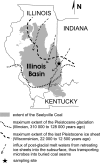Methane-producing microbial community in a coal bed of the Illinois basin
- PMID: 18310416
- PMCID: PMC2293134
- DOI: 10.1128/AEM.02341-07
Methane-producing microbial community in a coal bed of the Illinois basin
Erratum in
- Appl Environ Microbiol. 2008 Jun;74(12):3918
Abstract
A series of molecular and geochemical studies were performed to study microbial, coal bed methane formation in the eastern Illinois Basin. Results suggest that organic matter is biodegraded to simple molecules, such as H(2) and CO(2), which fuel methanogenesis and the generation of large coal bed methane reserves. Small-subunit rRNA analysis of both the in situ microbial community and highly purified, methanogenic enrichments indicated that Methanocorpusculum is the dominant genus. Additionally, we characterized this methanogenic microorganism using scanning electron microscopy and distribution of intact polar cell membrane lipids. Phylogenetic studies of coal water samples helped us develop a model of methanogenic biodegradation of macromolecular coal and coal-derived oil by a complex microbial community. Based on enrichments, phylogenetic analyses, and calculated free energies at in situ subsurface conditions for relevant metabolisms (H(2)-utilizing methanogenesis, acetoclastic methanogenesis, and homoacetogenesis), H(2)-utilizing methanogenesis appears to be the dominant terminal process of biodegradation of coal organic matter at this location.
Figures






References
-
- Anderson, R. T., and D. R. Lovley. 2000. Anaerobic bioremediation of benzene under sulfate-reducing conditions in a petroleum-contaminated aquifer. Environ. Sci. Technol. 34:2261-2266.
-
- Bekins, B. A., F. D. Hostettler, W. N. Herkelrath, G. N. Delin, E. Warren, and H. I. Essaid. 2005. Progression of methanogenic degradation of crude oil in the subsurface. Environ. Geosci. 12:139-152.
-
- Biddle, J. F., J. S. Lipp, M. A. Lever, K. G. Lloyd, K. B. Sørensen, R. Anderson, H. F. Fredricks, M. Elvert, T. J. Kelly, D. P. Schrag, M. L. Sogin, J. E. Brenchley, A. Teske, C. H. House, and K.-U. Hinrichs. 2006. Heterotrophic archaea dominate sedimentary subsurface ecosystems off Peru. Proc. Natl. Acad. Sci. USA 103:3846-3851. - PMC - PubMed
-
- Catcheside, D. E. A., and J. P. Ralph. 1999. Biological processing of coal. Appl. Microbiol. Biotechnol. 52:16-24.
MeSH terms
Substances
Associated data
- Actions
- Actions
- Actions
- Actions
- Actions
- Actions
- Actions
- Actions
- Actions
- Actions
- Actions
- Actions
- Actions
- Actions
- Actions
- Actions
- Actions
- Actions
- Actions
- Actions
- Actions
- Actions
- Actions
- Actions
- Actions
- Actions
- Actions
- Actions
- Actions
- Actions
- Actions
- Actions
- Actions
- Actions
- Actions
- Actions
- Actions
- Actions
- Actions
- Actions
- Actions
- Actions
- Actions
- Actions
- Actions
- Actions
- Actions
- Actions
- Actions
- Actions
- Actions
- Actions
- Actions
- Actions
- Actions
- Actions
- Actions
- Actions
- Actions
- Actions
- Actions
- Actions
- Actions
- Actions
- Actions
- Actions
- Actions
- Actions
- Actions
- Actions
- Actions
LinkOut - more resources
Full Text Sources
Other Literature Sources
Molecular Biology Databases

